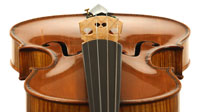|
Ref : 1036
A superb Italian violin by
|

go to Home Page see more Violins |
Alfredo G. Galea (1909-1994) was accredited as Master Violin Maker by the Italian National Association of Violin Makers in Rome, an accomplishment merited by the high quality of his work. The German researcher, Lütgendorff notes that Galea made his first violin at the age of 11 and by age 15 had completed 15 violins. His teacher at that time was the Italian violinmaker, Ami care Coschiera, who had a workshop in Alexandria.After the Second World War Galea moved to Durban in South Africa for a position as first violinist in the Durban Symphony Orchestra. At that time Durban was home to Amon Bilmark (1894-1961) - a former pupil of Simone Sacconi. Bilmark's studio and business dominated the entire country. Soon after his arrival in Durban in about 1946, Galea entered a partnership with Bilmark, but that lasted only briefly, until 1950.
Galea set up his own workshop. He would remain in South Africa for a total of about 16 years, alternating between Durban and Cape Town. By the late 50s he was firmly established as a violinmaker of a very high order.
During one of his concert tours to South Africa, Yehudi Menuhin met Galea. Menuhin was impressed by Galea's work and suggested that Galea should move to the United States. Menuhin eventually assisted him in emigrating to the US in 1962. Galea settled in Longbeach Ca. where he opened a violinmaking studio and shop. This studio was soon to dominate the violin community in that area and became noted for excellent repairs and restorations. For the next 32 years in the USA, Galea enjoyed the recognition he deserved and desired. He remained there for the rest of his life until his death on 28 July 1994, aged 84.
All Galea's violins are characterized by powerful and focussed concert-type tone, ideally suited for the performance of the big concertos. Galea commanded respect through is work. Ruggiero Ricci commissioned a violin from him in 1970. By 1979 Galea had made around 200 instruments and his life's work amounted to around 240 instruments. He made only two to four violins per year, and they are in the hands of professionals all over the world. So far I have not come across one that showed work of inferior quality or of poor tone. Being a good violinist, Galea knew what violinists wanted and didn't sell an instrument until it conformed to the tonal properties he expected and became known for.
In this violin, made in Cape Town in 1956, Galea departs from his usual model with its somewhat generous arching, in favour of a much flatter top and back. But in every other respect the hand is unmistakable - clean workmanship of a very high order, with impeccable attention to detail. One has to admire his tracing of purfling - virtually flawless. The corners are beautifully shaped, as are the lines and positioning of the f-holes - in this case with almost imperceptible asymmetry.
The choice of material is superb and Galea's characteristic light golden honey-coloured varnish with its high transparency shows the wood off to great advantage. As with the overwhelming majority of his instruments, the back is in one piece - in this case quite spectacular. This violin, as with all his violins from his South African period, bears his handwritten label and brand in the inside of the back.
 |
 |
 |
||
 |
Dimensions : Back length: 35.7 cm, Upper bouts: 16.6 cm, Inner bouts: 11.0 cm, Lower bouts: 20.8 cm
Condition : Excellent
Provenance : Withheld
Price : On request
 |
 |
 |
 |
 |
 |
 |
 |
 |
 |
 |
 |
|||||
 |
 |
 |
 |